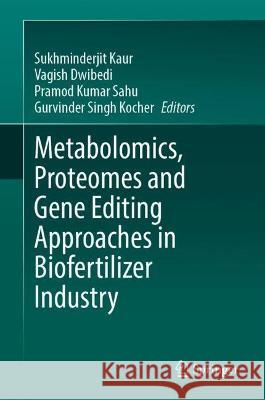Metabolomics, Proteomes and Gene Editing Approaches in Biofertilizer Industry » książka



Metabolomics, Proteomes and Gene Editing Approaches in Biofertilizer Industry
ISBN-13: 9789819935604 / Angielski
Metabolomics, Proteomes and Gene Editing Approaches in Biofertilizer Industry
ISBN-13: 9789819935604 / Angielski
(netto: 690,08 VAT: 5%)
Najniższa cena z 30 dni: 693,97
ok. 22 dni roboczych
Dostawa w 2026 r.
Darmowa dostawa!
Chapter 1. Constrains in biofertilizer industry and future scopes.- Chapter 2. Present scenario: Status of biofertilizer industry in India.- Chapter 3. Mode of application of biofertilizer in crop fields.- Chapter 4. Carrier based Biofertilizers.- Chapter 5. Liquid biofertilizers.- Chapter 6. Interaction of efficient rhizospheric bacteria and response in farmer’s field.- Chapter 7. Enhancing productivity through multiple microbial inoculants.- Chapter 8. Challages in compatibility of microbial inoculants with agrochemicals.- Chapter 9. Microbial metabolite-based products for plant growth promotion.- Chapter 10. Microbes from wild plants: Challenges and opportunities to be used as inoculant.- Chapter 11. Fungal biofertilizers: present trends and future prospects.- Chapter 12. Endophytes as plant growth inducers: a whole new arena in the inoculant industry.- Chapter 13. Immobilization and co-mobilization: An unexploited biotechnological tool for enhancing efficiency of biofertilizers.- Chapter 14. Microbial biostimulants: Bioformulations for enhanced biofertilizer efficacy and sustainable crop management.- Chapter 15. Omics approaches in strain improvement and new vistas in next-generation biofertilizers.- Chapter 16. Metabolomics and proteomics behind plant growth promoting potential of rhizobacteria.- Chapter 17. Proteomics in shaping future of biofertilizer delivery technique.- Chapter 18. Application of nanosilica for plant growth promotion and crop improvement.- Chapter 19. Industrial sustainability: Economics, cost and bioavailability of biofertilizers.- Chapter 20. Phyllosphere engineering: tailoring leaf surface microbes for boosting plant tolerance.
Dr. Sukhminderjit Kaur is an academic researcher in biotechnology with experience of more than 15 years. She received her doctorate degree in 2008 from Post Graduate Institute of Medical Education and Research, Chandigarh, India. Currently, she is working as Associate Professor and Research Coordinator in the Department of Biotechnology, Chandigarh University, Gharuan, Mohali, India.
Vagish Dwibedi did his Ph.D. from Thapar Institute of Engineering and Technology, Patiala, India. Dr. Dwibedi is an academic researcher with over eight years of experience in biotech research and development. He has conducted research projects and consultancy work in plant-microbe interaction/ bioassay-guided drug discovery and development, food security/sustainable agriculture and wastewater treatment. Presently he is working as a visiting postdoctoral scientist at the Agriculture Research Organization, Ministry of Israel (ARO), Rishon Lezhion, Israel.
Pramod Kumar Sahu, ICAR-National Bureau of Agriculturally Important Microorganisms, Maunath Bhanjan, Uttar Pradesh, India.Dr. Pramod Kumar Sahu has completed B.Sc. from IGKVV Raipur, M.Sc. (Gold Medalist), and Ph.D. (Agricultural Microbiology) from UAS, Bengaluru, India. He was a DST-Inspire fellow and has qualified for various national-level exams including ICAR-JRF, ICAR-SRF, ICAR-NET, ARS, and GATE.
Dr Gurvinder Singh Kocher, PhD in Microbiology is Principal Microbiologist and Head, Department of Microbiology, PAU. He has a teaching and research experience of 27 years and his area of interest is Fermentation, Industrial enzymes and Bioethanol production.
This edited book covers the major aspects of plant growth promoting bacteria and mechanisms underlining the phenotype in rhizobacteria. This book guides the researchers about the potential of plant growth promoting bacteria to be used as biofertilizers. The process of biofertilizer development and the process of testing its efficacy for commercial use and the potency is elaborated in this volume using suitable figures. The information in this book regarding the secretion of various secondary metabolites responsible for nutrient management is helpful for designing bioformulations that assist plant growth. This book provides substantial number of evidences that underlines the genomic basis of nutrient management by microbes. Essential information is provided regarding the genomic and proteomic background of the biofertilizers.
The chapters in the book are divided into three sections. The first section of the book includes chapter 1-5 outlining the importance of rhizobacteria in elevating the nutrient levels in soil and augmenting the biotic and abiotic stress. Second section of the book includes chapter 6-11 elaborating the details about the biofertilizer, types of biofertilizer available and techniques involved in mass production of biofertilizers. Section third covers chapters from 12-15 providing the explicit information about metabolomics and proteomics basis of plant growth development.
This collective work is distinct as it has focus on diverse emerging technologies which are high-throughput, scalable and applicable to different countries regardless of their socio-economic conditions. This book can improve the current state of knowledge and invoke researchers and innovators to take ahead the current inter-disciplinary knowledge into technologies that are readily available and effectively minimize hazards associated with chemical fertilizer.
1997-2025 DolnySlask.com Agencja Internetowa
KrainaKsiazek.PL - Księgarnia Internetowa









